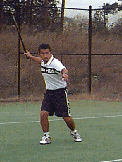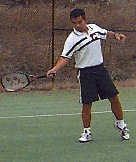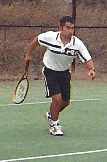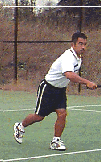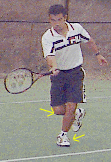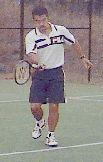|
TennisOne Lessons
The Groundstroke Approach Shotby Reggie Vasquez Jr.
The groundstroke approach shot: to rotate or not to rotate that is the question! Is it nobler to use rotational forces and angular momentum or to use that which provides forward propulsion called linear momentum? Dost thou have the answer? Look yonder, here cometh a revelation, a vision for our weary eyes to see. Well once again good ol' Shakespearean terminology makes a breakthrough, this time in a tennis article of all things. Simply put, I will discuss why some players will rotate more (Michael Chang, Agassi, Huber) while others will use less rotation and more linear momentum (Becker, Edberg, Mary J. Fernandez) when hitting a groundstroke approach shot. Later, I will try to link this up to our own usage. When we receive a short ball around the mid-court, we generally choose to use this opportunity to become aggressive and hit an approach shot. For terminology reasons, rotational or angular momentum will be defined as how the body turns in a circle-like fashion when hitting the ball. Linear momentum can be simply defined as forces that go in straight lines, in this case towards the net. Using Rotational ForceWhy does a player like Michael Chang, Andre Agassi or Monica Seles use such tremendous rotation when hitting an approach shot and less linear momentum? The answer is they use their strengths, which is to create tremendously powerful shots. Their intention behind the approach shot is to setup an easy volley. When this type of player sets up to hit the ball there is a small amount of actual forward or linear force moving towards the net. What does happen is that the player will use ground forces to load up the legs (store potential energy in quadriceps) and then explode upwards while simultaneously uncoiling or rotating the body for power just before impact of the ball. It should be noted that when the player uses the legs, the forces that are used to push the court surface actually lifts the player off of the ground before contact. You can try this yourself, bend your legs and then extend your legs with great force what happens? You lift off of the ground! When you are slowly moving forward setting up to a short ball, you use the ground such that the little momentum prior to impact will carry you a short distance forward. If you try to use too much forward momentum and also try to rotate, chances are you will do an out of control 360 and find yourself over rotating (after impact of the ball) with your back to the net.
The power player who uses more rotational movement in the upper body usually hits with an open stance, as I demonstrate in the frames above. The key item to note is that at the conclusion of this type of power stroke, the player lands on the right foot and the left foot will be trailing. If we drew a line on the ground outlining where the player made contact with the ball, we would notice that the distance traveled while in the air would be minimal. Potential problem areas when using more rotational force than linear forces: the first volley position will probably be further back because of the lack of forward movement. You will find that after a rotational approach shot, players will almost have to run to the net to get into a good volleying position. If you do not hit a good approach shot, you will be further away from the net when you receive your first volley. Using Linear MomentumWhy does a player like Stefan Edberg, Boris Becker or Mary J. Fernandez use more linear momentum and less rotational force? They use their strength, which is the volley and anticipation when receiving a passing shot. The intention behind this approach is to get as close to the net as possible in order to cut off any angles, thus blanketing the net in a good volleying position. When this type of player hits an approach shot there is much more forward momentum and this force creates speed of movement towards the net. Rotational or angular momentum is used but is minimal. Power on the shot is created by the legs pushing forward at impact as well as the racquet swing speed. This player will use ground forces to load up the legs (store potential energy in quadriceps) and then explode forwards and only slightly upwards. What is unique with this approach shot is how an advanced player will minimize or slow the body rotation when hitting the shot. Because the player relies on getting into a good volleying position close to the net, there is a great emphasis on forward momentum.
As I demonstrate in the frames above, when the player (right handed) is about to hit the approach shot he will be in nearly a closed stance, where the left foot is in front and the right foot is behind, the body is almost sideways to the net. When the player is about to hit the ball he will leave the ground slightly, make contact with the racquet in the air and then land (almost skipping forward) on that same left foot first, before bringing the right foot down which then immediately forces him to face the net. When the player leaves the ground the left leg stays straight and the right leg immediately bends at the knee 90 degrees. The right leg does not bend at the hip joint rather only at the knee joint. This bending of the right leg acts as an additional mass on a rotating body and this forces the rotational speed to be slower thus allowing the player to control the amount of rotation. If the right leg was not bent and the player used a lot of forward momentum the player would over-rotate and possibly fall because of the great speed forward and additional rotation. If we drew a line on the ground outlining where the player made contact with the ball, we would notice that the distance traveled while in the air would be much greater than the rotational player. Potential problem areas when using linear forward momentum forces: the power of the approach may under challenge the counter-attacker if not hit with enough pace. Lack of rotational power could cause less potential power on the shot. If you close too fast towards the net the momentum created may prevent you from suddenly retreating for a lob. Master Both MethodsHow do we determine if we should approach like Agassi or Edberg? I believe that you need to be able to hit both types of approach shots to be effective in today's tennis. There will be times when you see that your opponent is out of position and need to put some extra power on the shot to finish him off, a la Agassi style. Other times you will be approaching the net with your opponent in relatively good countering position. When this happens you may want to get into a really good volleying position close to the net, so that you can cover any passing shots hit. Generally speaking however, if you are not too tall then you may need
to be more aggressive with your approach to the net. You should really look
to force the other player into poor execution and hope to receive a easy
floating volley. If you are a taller player who can cover the net because
of sheer size, then you may want to hit more like Edberg and float right
into a good close volley position. In conclusion, no matter what type of
approach you choose to develop make sure that you are comfortable with the
shot. Now go out there and get 'em tiger! Send email to the author We encourage you to email your comments (pro, con, appreciative, whatever) directly to the author. To send email to Reggie Vasquez, click here. Reggie will also be speaking at the the upcoming tennis conferences in 1998: U.S.P.T.A. - California division and Ohio division U.S.P.T.R - International tennis symposium in Hilton Head, South Carolina. Tennis Canada - International conference in Toronto Tennis British Columbia - Vancouver. Reggie will be speaking on junior development using material from his book, "Kids' Book of Tennis...over 150 tennis games..." He hopes to see you there! To see Reggie Vasquez Jr's web site, go to: http://www3.sympatico.ca/let
Back to TennisONE Home Page webmaster@tennisone.com
|
